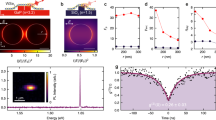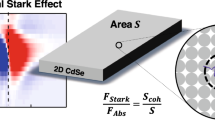Abstract
Intrinsically directional light emitters are potentially important for applications in photonics including lasing and energy-efficient display technology. Here, we propose a new route to overcome intrinsic efficiency limitations in light-emitting devices by studying a CdSe nanoplatelets monolayer that exhibits strongly anisotropic, directed photoluminescence. Analysis of the two-dimensional k-space distribution reveals the underlying internal transition dipole distribution. The observed directed emission is related to the anisotropy of the electronic Bloch states governing the exciton transition dipole moment and forming a bright plane. The strongly directed emission perpendicular to the platelet is further enhanced by the optical local density of states and local fields. In contrast to the emission directionality, the off-resonant absorption into the energetically higher 2D-continuum of states is isotropic. These contrasting optical properties make the oriented CdSe nanoplatelets, or superstructures of parallel-oriented platelets, an interesting and potentially useful class of semiconductor-based emitters.
This is a preview of subscription content, access via your institution
Access options
Access Nature and 54 other Nature Portfolio journals
Get Nature+, our best-value online-access subscription
$29.99 / 30 days
cancel any time
Subscribe to this journal
Receive 12 print issues and online access
$259.00 per year
only $21.58 per issue
Buy this article
- Purchase on Springer Link
- Instant access to full article PDF
Prices may be subject to local taxes which are calculated during checkout






Similar content being viewed by others
References
Basu, B. K. Theory of Optical Processes in Semiconductors (Oxford Univ. Press, 1997).
Ithurria, S. & Dubertret, B. Quasi 2D colloidal CdSe platelets with thicknesses controlled at the atomic level. J. Am. Chem. Soc. 130, 16504–16505 (2008).
Achtstein, A. W. et al. Electronic structure and exciton–phonon interaction in two-dimensional colloidal CdSe nanosheets. Nano Lett. 12, 3151–3157 (2012).
Joo, J., Son, J. S., Kwon, S. G., Yu, J. H. & Hyeon, T. Low-temperature solution-phase synthesis of quantum well structured CdSe nanoribbons. J. Am. Chem. Soc. 128, 5632–5633 (2006).
Wang, Q., Kalantar-Zadeh, K., Kis, A., Coleman, J. & Strano, M. Electronics and optoelectronics of two-dimensional transition metal dichalcogenides. Nat. Nanotech. 7, 699–712 (2012).
Kaasbjerg, K., Thygesen, K. S. & Jacobsen, K. W. Phonon-limited mobility in n-type single-layer MoS2 from first principles. Phys. Rev. B 85, 115317 (2012).
Perera, M. M. et al. Improved carrier mobility in few-layer MoS2 field-effect transistors with ionic-liquid gating. ACS Nano 7, 4449–4458 (2013).
Benchamekh, R. et al. Tight-binding calculations of image-charge effects in colloidal nanoscale platelets of CdSe. Phys. Rev. B 89, 035307 (2014).
Cheiwchanchamnangij, T. & Lambrecht, W. R. L. Quasiparticle band structure calculation of monolayer, bilayer, and bulk MoS2 . Phys. Rev. B 85, 205302 (2012).
Scott, R. et al. Time-resolved stark spectroscopy in CdSe nanoplatelets: exciton binding energy, polarizability, and field-dependent radiative rates. Nano Lett. 16, 6576–6583 (2016).
Chernikov, A. et al. Exciton binding energy and nonhydrogenic Rydberg series in monolayer WS2 . Phys. Rev. Lett. 113, 076802 (2014).
Naeem, A. et al. Giant exciton oscillator strength and radiatively limited dephasing in two-dimensional platelets. Phys. Rev. B 91, 121302 (2015).
Achtstein, A. W. et al. p-State luminescence in CdSe nanoplatelets: role of lateral confinement and a longitudinal optical phonon bottleneck. Phys. Rev. Lett. 116, 116802 (2016).
Poellmann, C. et al. Resonant internal quantum transitions and femtosecond radiative decay of excitons in monolayer WSe2 . Nat. Mater. 14, 889–893 (2016).
Wang, H. et al. Radiative lifetimes of excitons and trions in monolayers of the metal dichalcogenide MoS2 . Phys. Rev. B 93, 045407 (2016).
Schuller, J. A. et al. Orientation of luminescent excitons in layered nanomaterials. Nat. Nanotech. 8, 271–276 (2013).
Brown, S. J., Schlitz, R. A., Chabinyc, M. L. & Schuller, J. A. Morphology-dependent optical anisotropies in the n-type polymer P(NDI2OD-T2). Phys. Rev. B 94, 165105 (2016).
Pukhov, K. K., Basiev, T. T. & Orlovskii, Y. V. Spontaneous emission in dielectric nanoparticles. JETP Lett. 88, 12–18 (2008).
Chuang, S. L. & Chang, C. S. k·p method for strained wurtzite semiconductors. Phys. Rev. B 54, 2491 (1996).
Empedocles, S., Neuhauser, R. & Bawendi, M. Three-dimensional orientation measurements of symmetric single chromophores using polarization microscopy. Nature 399, 126–130 (1999).
Koberling, F. et al. Fluorescence anisotropy and crystal structure of individual semiconductor nanocrystals. J. Phys. Chem. B 107, 7463–7471 (2003).
Rodina, A. & Efros, A. Effect of dielectric confinement on optical properties of colloidal nanostructures. JETP Lett. 149, 641–655 (2016).
Lieb, M. A., Zavislan, J. M. & Novotny, L. Single-molecule orientations determined by direct emission pattern imaging. J. Opt. Soc. Am. B 21, 1210–1215 (2004).
Kim, D. Y. et al. Overcoming the fundamental light-extraction efficiency limitations of deep ultraviolet light-emitting diodes by utilizing transverse-magnetic-dominant emission. Light Sci. Appl. 4, e263 (2015).
Brütting, W., Frischeisen, J., Schmidt, T. D., Scholz, B. J. & Mayr, C. Device efficiency of organic light-emitting diodes: progress by improved light outcoupling. Phys. Status Solidi (A) 210, 44–65 (2013).
Schmidt, T. D. et al. Evidence for non-isotropic emitter orientation in a red phosphorescent organic light-emitting diode and its implications for determining the emitter's radiative quantum efficiency. Appl. Phys. Lett. 99, 163302 (2011).
Chen, X. et al. Angular distribution of polarized light and its effect on light extraction efficiency in AlGaN deep-ultraviolet light-emitting diodes. Opt. Express 24, A935–A942 (2016).
Ithurria, S. et al. Colloidal nanoplatelets with two-dimensional electronic structure. Nat. Mater. 10, 936–941 (2011).
The Merck Index Online, https://www.rsc.org/Merck-Index.
Achtstein, A. W. et al. Linear absorption in CdSe nanoplates: thickness and lateral size dependency of the intrinsic absorption. J. Phys. Chem. C 119, 20156–20161 (2015).
Dolgaleva, K. & Boyd, R. W. Local-field effects in nanostructured photonic materials. Adv. Opt. Photon. 4, 1–77 (2012).
Taminiau, T. H., Karaveli, S., van Hulst, N. F. & Zia, R. Quantifying the magnetic nature of light emission. Nat. Commun. 3, 979 (2012).
Adachi, S. Handbook on Physical Properties of Semiconductors (Kluwer Academic, 2004).
Yu, P. & Cardona, M. Fundamentals of Semiconductors (Springer, 1996).
Novotny, L. & Hecht, B. Principles of Nano-Optics (Cambridge Univ. Press, 2006).
Mooney, J. & Kambhampati, P. Get the basics right: Jacobian conversion of wavelength and energy scales for quantitative analysis of emission spectra. J. Phys. Chem. Lett. 4, 3316–3318 (2013).
Sihvola, A. & Kong, J. Effective permittivity of dielectric mixtures. IEEE Trans. Geosci. Remote Sens. 26, 420–429 (1988).
Loudon, R. The Quantum Theory of Light 3rd edn (Oxford Univ. Press, 2000).
Cunningham, P. D., Boercker, J. E., Placencia, D. & Tischler, J. G. Anisotropic absorption in PbSe nanorods. ACS Nano 8, 581–590 (2014).
Acknowledgements
R.S., U.W. and A.W.A acknowledge DFG grants WO477–1/32 and AC290-1/1 and 2/1. J.I.C. acknowledges support from MINECO project CTQ2014-60178-P and UJI project P1-1B2014-24, M.A. from the CHEMREAGENTS program and A.A. from BRFFI grant no. X16M-020.
Author information
Authors and Affiliations
Contributions
J.H., R.S., A.V.P. and N.G. performed measurements. A.V.P., A.A., A.M. and M.A. made samples. J.H., R.S., N.B.G. and A.W.A. analysed, modelled and interpreted the data. J.I.C. contributed theoretical interpretation. J.H., R.S., N.B.G, J.I.C., N.O. and A.W.A wrote the manuscript. U.W. contributed to discussions.
Corresponding author
Ethics declarations
Competing interests
The authors declare no competing financial interests.
Supplementary information
Supplementary information
Supplementary information (PDF 580 kb)
Rights and permissions
About this article
Cite this article
Scott, R., Heckmann, J., Prudnikau, A. et al. Directed emission of CdSe nanoplatelets originating from strongly anisotropic 2D electronic structure. Nature Nanotech 12, 1155–1160 (2017). https://doi.org/10.1038/nnano.2017.177
Received:
Accepted:
Published:
Issue Date:
DOI: https://doi.org/10.1038/nnano.2017.177
This article is cited by
-
Dipole–dipole-interaction-assisted self-assembly of quantum dots for highly efficient light-emitting diodes
Nature Photonics (2024)
-
Single-photon superradiance in individual caesium lead halide quantum dots
Nature (2024)
-
Direct linearly polarized electroluminescence from perovskite nanoplatelet superlattices
Nature Photonics (2024)
-
Optical anisotropy of CsPbBr3 perovskite nanoplatelets
Nano Convergence (2023)
-
Gigantic suppression of recombination rate in 3D lead-halide perovskites for enhanced photodetector performance
Nature Photonics (2023)



